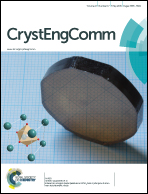Periodic and incommensurately modulated phases in a (2-methylimidazolium)tetraiodobismuthate(iii) thermochromic organic–inorganic hybrid†
Abstract
A (2-methylimidazolium)tetraiodobismuthate(III) (abbreviated as (2-MIm)BiI4) hybrid undergoes structural phase transition to an incommensurately modulated phase at 308 K. The relative coordinates of the modulation q-vector do not change down to 150 K indicating the stability of the incommensurate crystal packing that may be modeled by the sinusoidal waves of displacements. The transformation is triggered by the deformation of [BiI4−]n chains which entails ordering of 2-MIm+ counterions that couple to the anionic substructure via weak hydrogen bond interactions. Differential scanning calorimetry (DSC) and dielectric spectroscopy methods confirm the phase transition at 308 K (phase I → phase II). Two dielectric relaxation processes that may be assigned to the dynamics of the polar 2-MIm+ cations are present: a low frequency relaxator close to Tc and a high frequency one in a wide temperature region over phase II. The compound shows significant thermochromism characteristics for direct gap semiconductors. DOS calculations, together with the asymmetric local environment of bismuth ions, imply the presence of the stereochemically active bismuth lone pair 6s2 electrons in both phases.


 Please wait while we load your content...
Please wait while we load your content...